Madurai
How to Reach
Air
Madurai Airport was established in 1957 and is located at Avaniyapuram, about 12 kilometres (7.5 mi) from the city. It offers domestic flights to some cities in India. The airport was declared a customs airport in 2012. This designation allows a few international flights and international services to Colombo, Dubai, and Singapore. The carriers operating from the airport are Air India, Air India Express, Jet Airways, SpiceJet, Indigo and Srilankan Airlines.
Train
Madurai Junction is the major railway station serving the District. Madurai is the headquarters of the Southern Railway’s Madurai division. There are direct trains connecting Madurai with other major cities and towns across India. These include New Delhi, Mumbai, Calcutta, and Chennai.
Road
Madurai District is well connected with the National Highways. NH 7, NH 45B, NH 208, and NH 49 pass through Madurai. The state highways passing through the city are SH-33, SH-72, SH-72A, SH-73, and SH-73A. They connect various parts of Madurai district.
I Square Taxi in Madurai
Discover Madurai with I Square Taxi
At I Square Taxi, we offer convenient One-way Drop Taxi, Drop Taxi, and Round Trip services. We cater to travelers in need of Outstation Taxi, Intercity Taxi, or One-way Taxi options.
Madurai, a city steeped in history and spirituality, is centered around the magnificent Meenakshi Sundareswarar Temple. This ancient twin temple, dedicated to Lord Shiva (Sundareswarar) and Goddess Meenakshi, has been the heart of Madurai’s evolution. The temple spans over 65,000 square meters. It was first built nearly 2,000 years ago. Significant expansion took place under Thirumalai Nayak between 1623 and 1655 AD. Enclosed by four towering gateways, this temple is a spiritual and architectural marvel.
Another significant religious site is the Thirupparankundram Temple, located 8 kilometers south of Madurai. It is one of the six sacred abodes of Lord Subramanya. Its innermost shrine is carved from solid rock. This showcases the ancient artistry of the region. Additionally, Alagar Koil is a renowned Vishnu temple situated 21 kilometers northeast of Madurai. It is set amidst picturesque surroundings on the Solaimalai Hill. The temple is a must-visit for its serene beauty and intricate carvings. Further atop the hill lies Palamudirsolai, another of Lord Subramaniya’s six sacred abodes.
You may be exploring these spiritual landmarks. Or, you might be traveling within the region. I Square Taxi is your reliable partner for seamless and comfortable journeys.
Tourism with I Square One Way Drop Taxi in Madurai
Unveil the Legends of Madurai with I Square Taxi
At I Square Taxi, we offer seamless travel services. Our options include One-way Drop Taxi, Drop Taxi, and Round Trip. These are perfect for those seeking Outstation Taxi, Intercity Taxi, or One-way Taxi services.
According to ancient legend, Madurai was once a vast forest known as Kadambavanam. One day, a farmer named Dhananjaya saw the god Indra worshipping a self-manifested Lingam beneath a kadamba tree. This remarkable sight was reported to King Kulasekara Pandya. He then cleared the forest and built a temple around the sacred Lingam. The settlement of Madurai developed with the temple as its focal point. During the naming ceremony, Lord Shiva is believed to have appeared. Drops of nectar fell from his hair onto the land. Hence, the name Madurai means “sweetness” in Tamil.
Anyone who wants to explore the legendary and spiritual richness of Madurai can rely on us. I Square Taxi provides a comfortable and reliable ride for your journey.

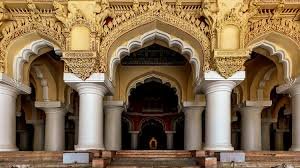


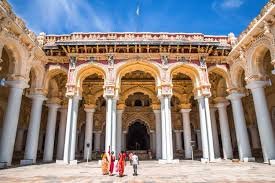
About 1.5 Kms from the Meenakshi temple, this palace was built in 1636 by the ruler whose name it bears. The imposing edifice is famous for the “Stuccowork” on its domes and impressive arches. The Sorgavilasam (Celestial Pavilion), measuring 75m x 52m, is constructed entirely of brick and mortar. It lacks the support of a single rafter or girder. This structure is a marvel of Indo-Saracenic architectural style. The palace features massive white pillars. Several pillars line the corridor that runs along the courtyard.
Connected by high decorated arches, these pillars measure 20m in height and have a circumference of 4m. Elsewhere, there are polished black stone pillars of varying heights. King Thirumalai Nayak’s grandson demolished much of the fine structure. He removed most of the jewels and woodcarvings. He did this to build his own palace in Tiruchirapalli. (His dream never came true).
Lord Napier, the then Governor of Madras, partially restored the palace in 1866-72. Later restoration works were carried out several years ago. Thanks to these efforts, today we get to see the Entrance Gate, The Main Hall, and the Dance Hall. There’s daily sound and light show in English at 1845 hrs and in Tamil at 2015 hrs. This half an hour show highlights King Thirumalai’s virtues. It focuses on his passion for arts, his victories in battle, and his love for his subjects.





One of the six special abodes dedicated to Lord Murugan or Lord Subrahmanya is located 8 Kms South of Madurai. This temple is important. The marriage of Lord Subrahmanya with Devayanai, the daughter of Indra, was celebrated here. The Cave shrines here are calculated as 8th century creation of the Pandiyans. The Sanctum Sanctorum is carved out of a single rock. The temple has been in existence for many centuries. The walls and the pillars have fascinating carvings.





Synonymous with Madurai is the Meenakshi Sundareswarar twin Temple, the pivot around which the city has evolved. The Meenakshi Temple complex is literally a city. It is one of the largest of its kind in India. It is undoubtedly one of the oldest too. Each dynasty and victorious monarch contributed to the temple’s growth. It became an enormous complex extending over an area of 65000 Sq m. The temple was founded 2000 years ago. It was substantially expanded during the regime of Thirumalai Nayak(1623-55 AD).
Lord Siva in his incarnation as Sundareswarar and his fish-eyed spouse, Meenakshi, are enshrined in this twin temple. There are five massive gateways enclosing these two shrines. Even a casual visitor is fascinated by the many paintings and sculptures.
A striking feature of the temple is the astonishing structure known as “Ayiramkaal Mandapam” or the Hall of Thousand Pillars. Each pillar features high, ornate, bold sculptures. These sculptures look life like. From any angle, these pillars appear to be in a straight line. It is an architectural masterpiece indeed. In the outermost corridors are situated the matchless musical pillars carved out of stones. When it is tapped, each pillar produces different musical note.
Timings : The temple is usually open between 0500hrs and 1230hrs and again between 1600 hrs and 21.30 hrs.
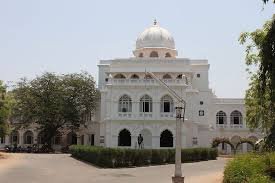
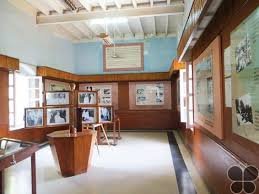



The Gandhi Museum is housed in the old Palace of Rani Mangammal. It depicts the highlights of the freedom struggle. The museum holds a picture gallery of the Gandhian movement. Also can be seen are a gallery of relics, Khadi and village industries section and South Indian Handicrafts section.



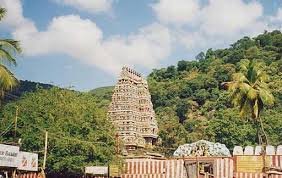

About 21 Kms North East of Madurai, stands a celebrated Vishnu Temple dedicated to Lord Alagar. The temple is situated on a hill amidst panoramic surroundings. The shrine is know as Alagarkoil and the hill , Solaimalai. The temple also contain some beautiful carvings and makes the visit rewarding. Palamudirsolai, one of the six abodes of Lord Subramaniya is located atop the Hill.





Mariamman Teppakulam is a beautiful square tank spread over a huge area of almost 16 acres. It is located about 4 Kms East of Meenakshi Temple in Madurai City. The tank hosts the colourful float festival in January/February. This festival celebrates the birth anniversary of King Thirumalai Nayak. He built this tank. The deities of Meenakshi and Sundareswarar are placed in a float. The float, called “Teppam”, is decorated with flowers and illuminated with hundreds of lights. This float is taken around the tank to the sound of traditional music. On the Northern side of the tank a temple is dedicated to Mariamman, a famous village deity of Tamil Nadu.
Festivals and Events
Pongal (Harvest Festival) – January :
Pongal or the Harvest Festival is celebrated by paying tribute to the Sun. People honor Nature and cattle for helping them with a rich harvest. The 3 day festival is celebrated with great pomp and splendour. Bogi is celebrated the first day. Homes are given a fresh lick of paint and old articles are removed. The second day is Pongal, the main festival. Sugarcanes, Pongal (a sweet variety of rice) and festoons of mango leaves mark this auspicious day. Mattu Pongal is celebrated the third day. On this day people pay tribute to the cattle for bringing in prosperity.
Jallikattu (Taming the Bull) – January :
The most popular sport in Tamil Nadu is part of the pongal celebrations. This game of valour is held in the villages with great pomp and splendor though only as a popular sport. People from the neighbouring villages throng the open grounds to watch man and beast pitting their strength against each other.
Chithirai Festival (April/May) :
It is celebrated every year on the Full moon day of the Tamil Month Chithirai. (April/May). According to legend, Lord Vishnu, as Alagar, rode a golden horse to Madurai. He was attending the celestial wedding of Goddes Meenakshi with Lord Sundareswarar (Lord Siva). This festival is marked by solemnity and serenity.
Festival of the Cradle (June- July) :
The festival features a procession for the deities. Goddess Meenakshi and Lord Sundareswarar (Lord Siva) are taken to a mirror chamber. For nine days they are on a swing, which rocks gently.
Avanimoolam Festival (August / September) :
This festival during August / September celebrates the coronation of Lord Sundareswarar (Lord Siva). Daily, a “Lila” or play is performed. The temple priest recites the stories of Lord Siva in 64 miracles. These miracles protected the city of Madurai from adversity. One significant event is the coronation performed for Sundareswarar. Another important event is Lord Sundareswarar (Lord Siva) carrying soil for earning pittu, which would be enacted.
Navarathri (Nine nights) Festival (September) :
Goddess Meenakshi would appear in a separate dress each day during this nine-day festival. She would bless the devotees at the `kolu mandapam’ in Amman Sannidhi. The entire temple would be lit in colour lamps. The dolls would be arranged to find a niche in the hearts of the devotees. This festival is held in honour of Goddess Meenakshi in all her forms, which embody fury, compassion and wisdom.
Dance Festival (January/ March/ November/ December) :
A dance festival is being organized by the Tourism Department for Fifteen days. Exponents of various dances forms from all over the country participate in this festival.